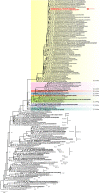Detection and phylogenetic analysis of highly pathogenic A/H5N1 avian influenza clade 2.3.4.4b virus in Chile, 2022
- PMID: 37254689
- PMCID: PMC10283444
- DOI: 10.1080/22221751.2023.2220569
Detection and phylogenetic analysis of highly pathogenic A/H5N1 avian influenza clade 2.3.4.4b virus in Chile, 2022
Abstract
Highly pathogenic avian influenza (HPAI) A/H5N1 viruses continue to pose a significant threat to animal and human health worldwide. In late 2022, the first confirmed case of HPAI A/H5N1 infection in wild birds in Chile near the Chilean-Peruvian border was reported. Active surveillance by our group in the adyacent Lluta river estuary revealed an increase in A/H5N1 prevalence coinciding with the arrival of migratory birds from the Northern Hemisphere. Genomic analysis of A/H5N1-positive samples demonstrated a close genetic relationship to strains detected in Peru during the same period, which originated from A/H5N1 viruses causing outbreaks in North America. Notably, we identified genetic mutations that did not correlate with known enhanced transmission or binding traits to mammalian receptors. In summary, this study provides valuable genomic insights into the A/H5N1 Clade 2.3.4.4b viruses in wild birds in Chile, emphasizing the need for enhanced surveillance and response strategies to mitigate the threat posed by these highly pathogenic avian influenza viruses in South America.
Keywords: Avian influenza; Chile; HPAI; South America; phylogenetic analysis; wild birds.
Conflict of interest statement
No potential conflict of interest was reported by the author(s).
Figures

References
MeSH terms
LinkOut - more resources
Full Text Sources
Other Literature Sources
Medical
